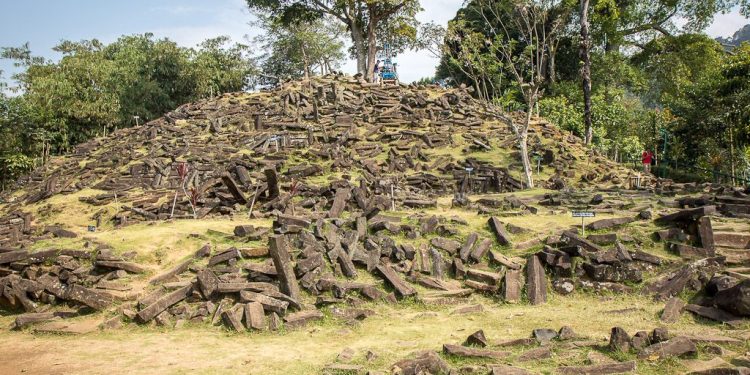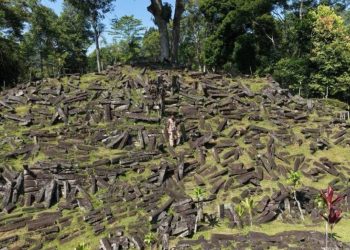Jakarta, Indonesia Sentinel — Researchers conducting restoration and further study at the Gunung Padang site in West Java have reported three new discoveries, uncover the mysteries of the prehistoric site, believed to be older than Egypt’s Pyramids of Giza.
Ali Akbar, head of the research team, said the group has been working for the past two weeks and will continue its efforts to study the sites. This effort has lead to the new discoveries by the team: the stone material, a stepped structure beside a staircase, and supporting pillars leading to a possible underground chambers formation.
“One of our findings shows that the stone material at Gunung Padang originates from Mount Pasir Pogor, located about five kilometers away. The mountain is made up of rocky formations, and our team discovered lines forming a rectangular pattern,” Ali told, as reported by Antara on Monday (Aug. 18).
Samples from the site will be analyzed in a laboratory to determine whether they match the rocks found at Gunung Padang. The long pentagon-shaped stone blocks are believed to have formed as a result of volcanic activity millions of years ago.
Volcanic processes typically produce dense rock. Initial studies indicated that some of the material at the site came from Ciukir, an area two kilometers south of Gunung Padang.
“After closer observation, we found a rock formation to the north of the site resembling those at Gunung Padang. Samples have been taken and will be tested in a lab, with results expected in three weeks,” Ali said.
Read Also:
The research also revealed a stepped structure beside the staircase leading to the main terrace of Gunung Padang. From midway up the stairs, researchers observed a distinctive formation among trees growing on level ground outside the main terrace.
The discovery suggests that Gunung Padang is part of a massive architectural complex, rather than just the five terraces visible from the surface. Previous studies indicated the presence of structures buried tens of meters underground, possibly including a large chamber.
In addition, the team identified upright stones believed to be supporting pillars connected to the underground structure. Several large stones extending deep into the ground may function as load-bearing supports for the main buried structure.
“We will continue investigations using lidar and other tools to gradually uncover the many mysteries that have remained hidden at this site,” Ali said.
(Raidi/Agung)
























